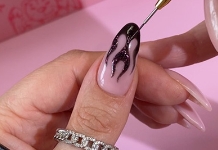UPDATED: Reopening with Confidence: Your guide to salon safety
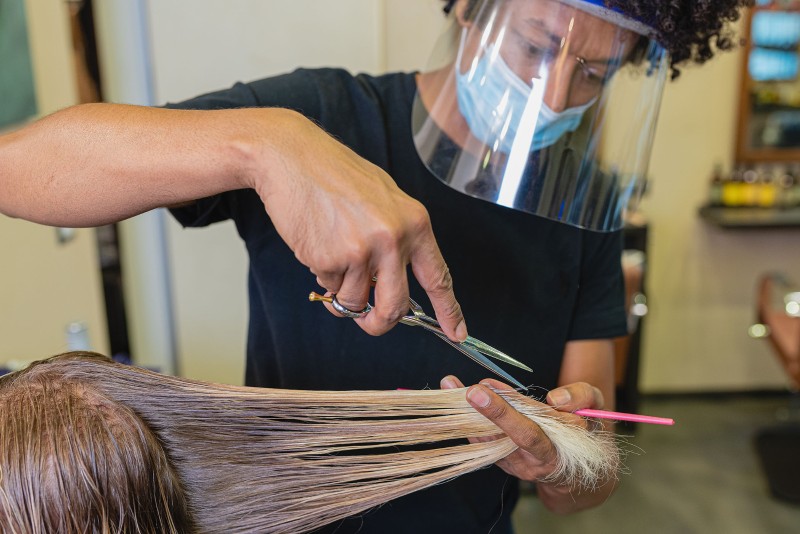
Updated: 10.4.2021
The UK government has issued guidance for those who work within close contact services including beauty therapists, nail technicians, hairdressers, barbers, tattooists, sports and massage therapists, for when businesses reopen to ensure that transmission levels of COVID-19 are kept to a minimum.
Professionals are reminded that it is mandatory in law for people providing a close contact service to wear a clear visor/goggle and Type II Face Mask.
The government worked with a range of stakeholders in the beauty industry to develop the measures close contact services will need to consider to become COVID-19 secure, which in brief include:
- The mandatory wearing of face coverings by clients (unless medically exempt) and a clear visor/goggle and Type II Face Mask by staff.
- Using screens or barriers to separate clients from each other, and to separate practitioners from clients, such as in nail salons.
- Operating an appointment-only booking system to minimise the number of people on the premises at any one time.
- Keeping the activity time involved to a minimum.
- Increasing the frequency of hand washing and surface cleaning, as well as regularly cleaning equipment or using disposable equipment where possible.
- Avoiding skin to skin contact and wearing gloves where it is not crucial to the service, such as in nail bars and tanning salons.
- Maintaining sufficient spacing between customer chairs.
- Not allowing food or drink, other than water, to be consumed in the salon by customers.
- Making sure a limited and fixed number of workers work together, if they have to be in close proximity to do their jobs.
Full guidance can be found
online.
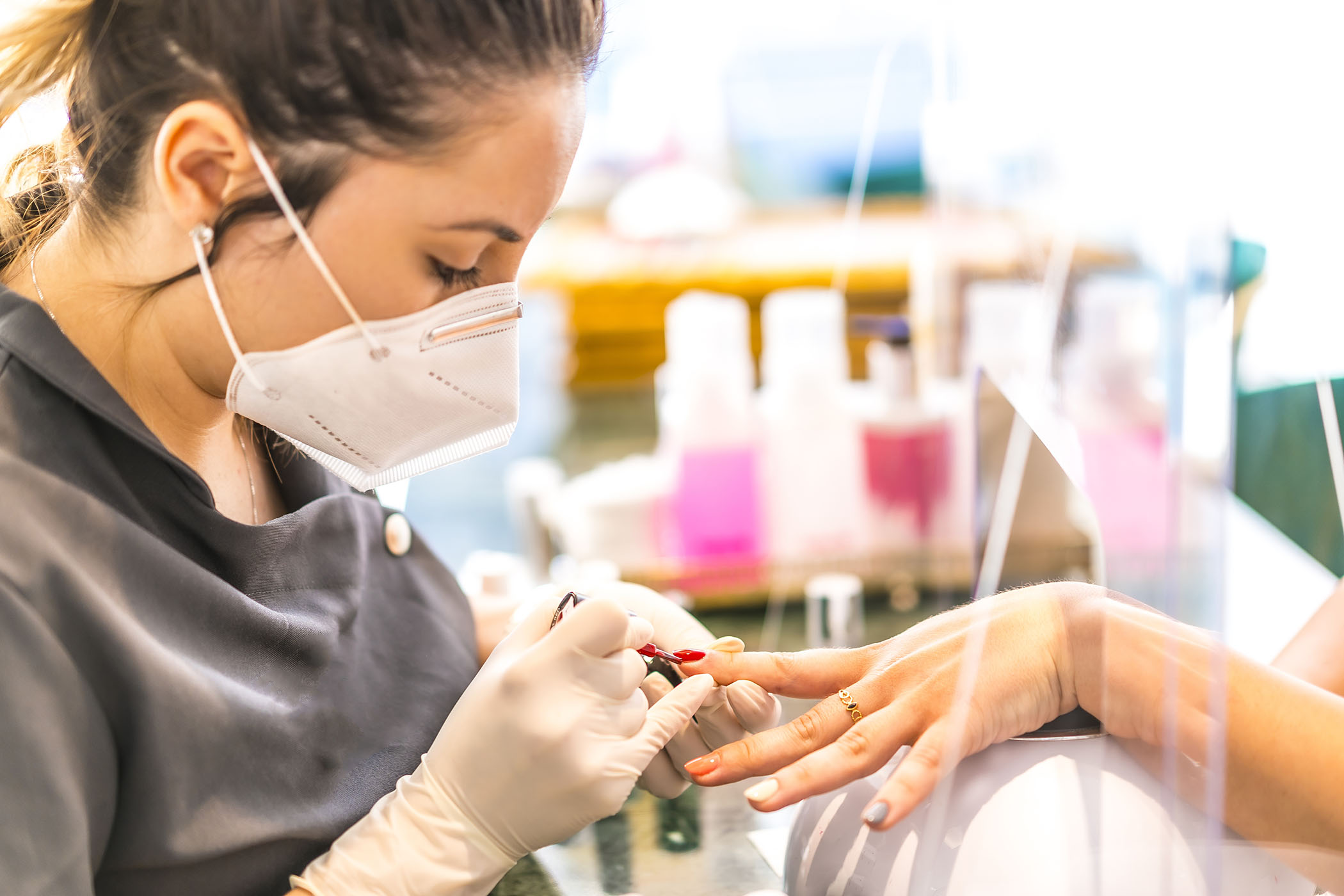
Government guidance says that the following COVID-19 related screening questions should be asked of clients ahead of their appointment:
- Have you had the recent onset of a new continuous cough?
- Do you have a high temperature?
- Have you noticed a loss of, or change in, normal sense of taste or smell?
If the client has any of these symptoms, however mild, the government advises they should stay at home, and book a COVID-19 test.
Salon cleanliness and hygiene
To prevent COVID-19 transmission, you should keep all surfaces clean. The government guidance advises that you do this by:
- Spacing appointments to allow for frequent cleaning of work areas and equipment between uses, using your usual cleaning products.
- Frequently cleaning objects and surfaces that are touched regularly, including door handles or staff handheld devices, and make sure there are adequate disposal arrangements for cleaning products.
- Clearing workspaces and removing waste and belongings from the work area at the end of a shift, including not providing reading materials such as magazines in client waiting areas.
- Sanitising any reusable equipment, including client chairs, treatment beds, and equipment, such as scissors used after each appointment, and at the start and end of shifts.
- Using disposable gowns for each client. Where this is not possible, use separate gowns (and towels in the normal way) for each client, washing between use and dispose of appropriately as required.
- Encouraging staff not to wear their uniforms at home or to and from the workplace, to change uniforms daily and to wash immediately after use.
- Maintaining good ventilation in the work environment, for example keeping windows or doors open. The government advise that you should check whether your salon ventilation system needs servicing or adjusting, for example so that they do not automatically reduce ventilation levels due to lower than normal occupancy levels. Most air conditioning systems do not need adjustment, however where systems serve multiple buildings, or you are unsure, advice should be sought from your heating ventilation and air conditioning (HVAC) engineers or advisers.
If you are cleaning after a known or suspected case of COVID-19 then you should refer to the specific government guidance.
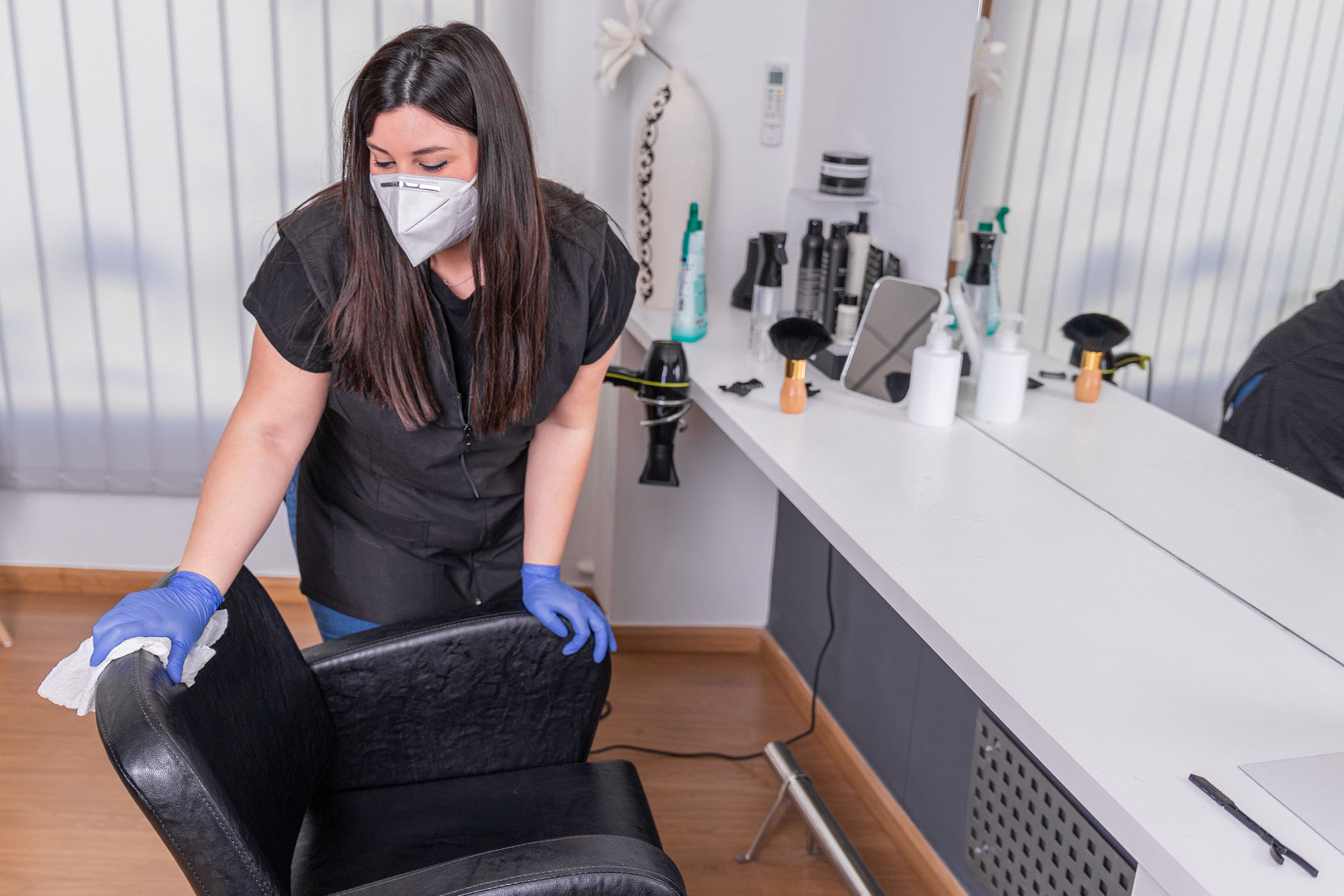
If you employ staff, you have a duty of care to reduce the risk to your staff of contracting COVID-19, and making the workplace risk the lowest reasonably practical by carrying out a risk assessment.
The government advises this is done by:
- Ensuring both workers and clients who feel unwell stay at home and do not attend the premise.
- Increasing the frequency of handwashing and surface cleaning.
- Keeping the activity time involved as short as possible.
- Making every reasonable effort to comply with the social distancing guidelines set out by the government (2m, or 1m with risk mitigation where 2m is not viable, is acceptable. You should consider and set out the mitigations you will introduce in your risk assessments).
- Where the social distancing guidelines cannot be followed in full, in relation to a particular activity, you should consider whether that activity needs to continue for the business to operate, and if so, take all the mitigating actions possible to reduce the risk of transmission between their staff.
- Clearly, when providing close contact services, it often may not be possible to maintain social distancing guidelines (2m, or 1m apart with risk mitigation, is acceptable). As a result, personal protective equipment in the form of a clear visor/goggle and Type II Face Mask worn by therapists/hairdressers will be required to mitigate the risk.
- Using screens or barriers to separate clients from one another. If the practitioner is wearing a clear visor/goggle and Type II Face Mask, screens will not provide additional protection between the practitioner and the individual.
- Everyone working in close proximity for an extended period must wear a clear visor/goggle and Type II Face Mask.
- Using back-to-back or side-to-side working (rather than face-to-face) whenever possible.
- Using a consistent pairing system, defined as fixing which workers work together, if workers must be in close proximity (defined as being within arm's-length of someone else for a sustained period of time).
- If people must work face-to-face for a sustained period with more than a small group of fixed partners, then you will need to assess whether the activity can safely go ahead. Services which require workers to be within the ‘highest risk zone' of clients (defined as the area in front of the face where splashes and droplets from the nose and mouth, that may not be visible, can be present and pose a hazard from the client to the practitioner and vice versa), for the entire duration or the majority of the time the service is being provided, should not be resumed unless they can be adapted in line with this guidance to make them safe (for example, by moving out of the highest risk zone and wearing a clear visor/goggle and Type II Face Mask).
- The closer someone is to the source of the virus, the greater the risk of transmission. Particular attention should also be paid to avoiding contact with surfaces near to the client and thoroughly cleaning those surfaces after each client. No one is obliged to work in an unsafe work environment.
- The closer someone is to the source of the virus, the greater the risk of transmission. Particular attention should also be paid to avoiding contact with surfaces near to the client and thoroughly cleaning those surfaces after each client. No one is obliged to work in an unsafe work environment.
In your assessment you should have particular regard to whether the people doing the work are especially vulnerable to COVID-19.
Salon working hours & appointments
To ensure that your practices do not discriminated against any members of your team, the government suggest you:
- Be mindful of the particular needs of different groups of workers or individuals.
- Remember is against the law to discriminate, directly or indirectly, against anyone because of a protected characteristic such as age, sex, disability, race or ethnicity.
- Be aware that as an employer you have particular responsibilities towards disabled workers and those who are new or expectant mothers.
- Considering whether you need to put in place any particular measures or adjustments to take account of your duties under the equality's legislation.
- Understand and consider the circumstances of those with different protected characteristics.
- Involve and communicate appropriately with workers whose protected characteristics might either expose them to a different degree of risk, or might make any steps you are thinking about inappropriate or challenging for them.
- Make reasonable adjustments to avoid disabled workers being put at a disadvantage and assessing the health and safety risks for new or expectant mothers.
Make sure that the steps you take do not have an unjustifiable negative impact on some groups compared to others, for example those with caring responsibilities or those with religious commitments.
Staff training
To ensure that staff are aware of the changes that may have been made to their working environment and their working practices, the government suggests that you:
- Develop communication and training materials for workers prior to returning to the salon, especially around new procedures for arrival at work.
- Provide clear, consistent and regular communication to improve understanding and consistency of ways of working.
- Engage with workers and worker representatives through existing communication routes to explain and agree any changes in working arrangements.
- Use simple, clear messaging to explain guidelines using images and clear language, with consideration of groups for which English may not be their first language and those with protected characteristics such as visual impairments.
- Engagement with staff on an ongoing basis to monitor and understand any unforeseen impacts of changes to working environments.
- Be aware and focus on the importance of mental health at times of uncertainty. The government has published guidance on the mental health and wellbeing aspects of coronavirus (COVID-19).
- Use visual communications, for example whiteboards or signage, to explain changes to appointment schedules or stock shortages without the need for face-to-face communications.
- Ensure staff understand how to use and clean their PPE.
Social distancing for staff
You should put into practice any changes required to ensure that workers maintain social distancing guidelines (2m, or 1m with risk mitigation where 2m is not viable, is acceptable) wherever possible, including while arriving at work, whilst at work, and when leaving work.
When providing close contact services, the nature of the work is such that maintaining social distancing will not usually be possible when actively serving a client. In these circumstances, both employers, staff and freelancers (self-employed) who may be working in the salon/spa environment should do everything they reasonably can to reduce risk.
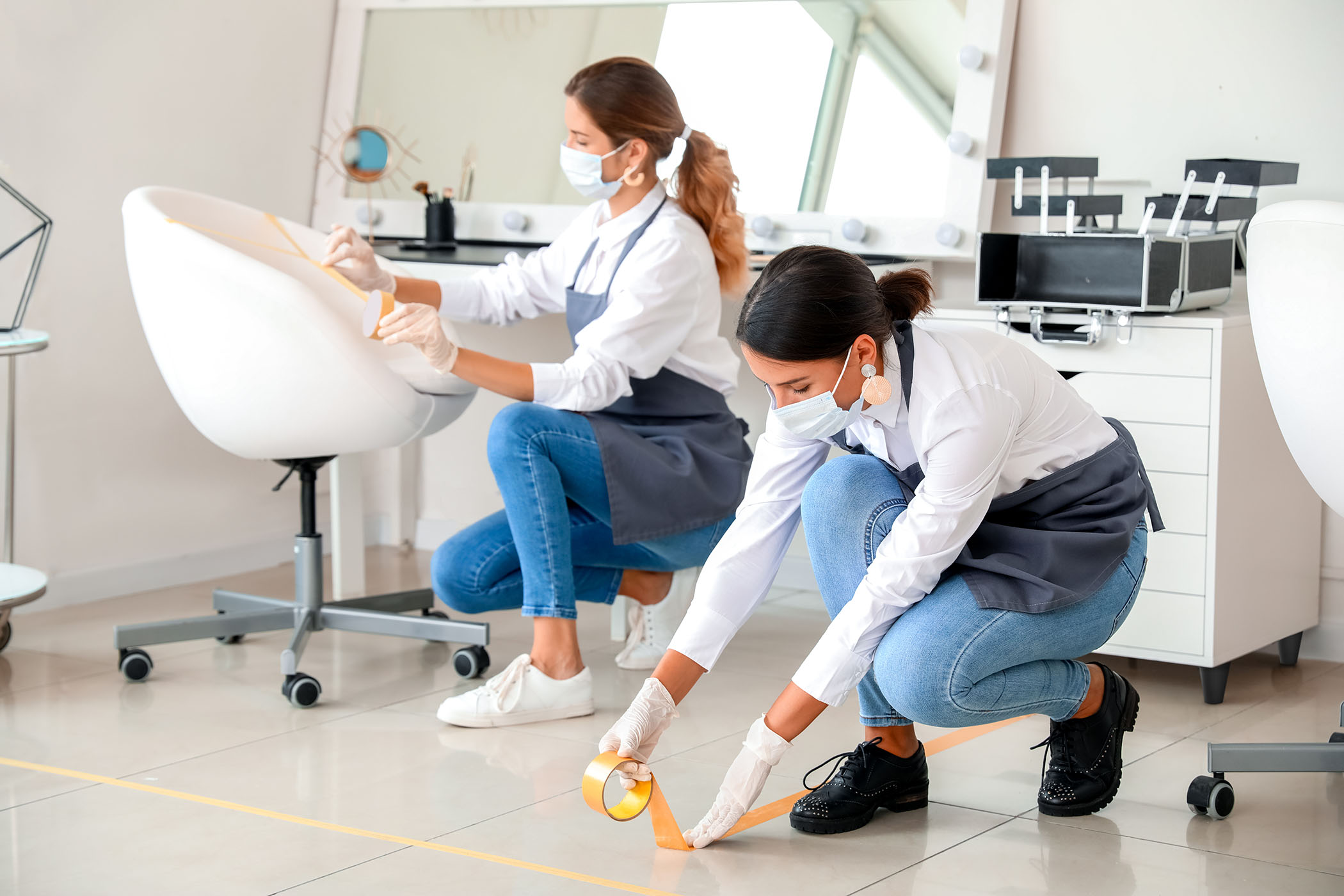
- Further increasing the frequency of hand washing and surface cleaning.
- Keeping the treatment time involved as short as possible.
- Using screens or barriers to separate clients from one another. If the practitioner is wearing a clear visor/goggle and Type II Face Masks, screens will not provide additional protection between the practitioner and the individual.
- Using back-to-back or side-to-side working (rather than face-to-face) whenever possible.
- Using a consistent pairing system if workers must be in close proximity.
- Only opening client waiting areas where social distancing can be maintained.
- Maintaining social distancing between the treatment or service areas, such as client chairs.
- Social distancing applies to all parts of a business or home, not just the room where the service is delivered, but waiting rooms, corridors and staircases, where applicable.
Staff arriving and leaving the salon
You should aim to maintain social distancing as much as possible for staff arriving and leaving the working environment. Government guidance suggests:
- Staggering arrival and departure times at work to reduce crowding into and out of the workplace, taking account of the impact on those with protected characteristics.
- Providing additional parking or facilities such as bike-racks to help people walk, run, or cycle to work, recognising this may not be possible in smaller workplaces.
- Reducing congestion, for example, by having more entry points to the workplace, where possible.
- Using markings and introducing one-way flow at entry and exit points, where possible.
- Providing handwashing facilities (or hand sanitiser where not possible) at entry and exit points.
- Collaborating with other businesses who may share the premises to minimise the numbers of people on site.
- Remind staff that wearing a face covering is required by law when travelling as a passenger on public transport in England.
Keeping working areas safe for staff
Workstations, such as treatment chairs, back wash stations, nail tables etc, should allow staff to maintain social distancing wherever possible. If it is not possible to ensure working areas comply with social distancing guidelines (2m, or 1m with risk mitigation where 2m is not viable, is acceptable), you should consider whether that activity needs to continue for the business to operate, and if so take all mitigating actions possible to reduce the risk of transmission.
Workstations should be assigned to an individual as much as possible. If they need to be shared, they should be shared by the smallest possible number of people.
The government suggests implementing the following changes if necessary:
- Review layouts and processes to maintain social distancing (2m, or 1m with risk mitigation where 2m is not viable, is acceptable) between clients being served simultaneously, ensuring there is sufficient spacing between client chairs, for example, closing off alternate chairs.
- Use floor tape or paint to mark areas to help people comply with social distancing guidelines (2m, or 1m with risk mitigation where 2m is not viable, is acceptable).
- Ask clients to arrive at the scheduled time of their appointment and only provide a waiting area if social distancing can be maintained.
- Avoid overrunning or overlapping appointments and contact clients virtually to let them know when they are ready to be seen, where possible.
- Using screens to create a physical barrier between workstations, where this is practical. This will not be required between the practitioner and client when the practitioner is wearing a clear visor/goggle and Type II Face Mask.
- Use a consistent pairing system, defined as fixing which workers work together, if workers must be in close proximity. For example, this could include a stylist and apprentice.
- Minimise contacts around transactions, for example, considering using contactless payments including tips, where possible.
- Minimise how frequently equipment is shared between workers, frequently cleaning between use and assigned to an individual where possible.
- Use disposable items where possible, for example nail files, and ensuring non-disposable items are cleaned between clients.
Keeping common areas and staff rooms safe
Government guidance recommends the following to maintain safety in areas used by more than one person and staff areas:
- Stagger break times to reduce pressure on the staff break rooms or places to eat and ensure social distancing is maintained in staff break rooms.
- Use safe outside areas for breaks.
- Install screens to protect workers in receptions or similar areas.
- Encourage workers to bring their own food and drinks. Do not allow food or drink to be consumed in the salon by clients other than water in disposable cups or bottles.
- Reconfigure seating and tables, such as in waiting areas, to optimise spacing and reduce face-to-face interactions.
- Encourage workers to remain on-site for their shift.
- Consider the use of social distance marking for other common areas such as toilets, staff rooms, changing rooms and in any other areas where queues typically form.
- Use signs and posters to build awareness of good handwashing technique, the need to increase handwashing frequency and to avoid touching your face, and to cough or sneeze into a tissue which is binned safely, or into your arm if a tissue is not available.
- Prepare materials and equipment in advance of scheduled appointments, such as scissors or hairbrushes in hairdressers, to minimise movement to communal working areas.
- Schedule appointments to avoid client congestion in waiting areas, particularly in establishments with smaller waiting areas.
- Only the client should be present in the same room for appointments in the home.
- Revise the staff kitchen layout
- Provide a secure area where social distancing is maintained for a client when services or treatments require development time, for example hair colouring.
Personal Protective Equipment (PPE)
PPE can protect you against the health and safety risks you and your staff may be exposed to at work. Even when wearing PPE, you should still aim to maintain social distancing guidelines (2m, or 1m with risk mitigation where 2m is not viable, is acceptable).
It is mandatory in law for people providing a close contact service to wear a clear visor/goggle and Type II Face Mask.
The government's document
Keeping Workers and Clients Safe During COVID-19 Close Contact Services states:
“In workplaces such as hairdressers and barbers, beauty salons and tattoo and photoshoot studios, it is likely to be difficult to maintain social distancing, as employees need to work in close proximity to their clients, usually for an extended period of time. An extended period of time refers to the majority of the working day, irrespective of the number of clients served during the day. The person providing a service (such as hairdressers, because of the period of time spent in close proximity to a person's face, mouth and nose) should therefore wear further protection in addition to any that they might usually wear.
“This should take the form of a clear visor that covers the face and provides a barrier between the wearer and the client from respiratory droplets caused by sneezing, coughing or speaking. Visors must fit the user and be worn properly. It should cover the forehead, extend below the chin, and wrap around the side of the face.”
You may use either a disposable or re-usable visor, which must be cleaned and sanitised regularly using normal cleaning products.
Goggles may be used as an alternative to a clear visor, when worn with a Type II Face Mask. Goggles goggles must be close fitting with no obvious openings or vents that would otherwise allow droplets to enter the eyes. Reusable eye protection should be cleaned according to the manufacturer's instructions.
The Government advises avoiding skin to skin contact and wearing gloves where it is not crucial to the service, such as in nail bars and tanning salons. Each individual business should determine ‘crucial'.
Beyond a clear a clear visor/goggle and Type II Face Mask, there is no requirement by the government for beauty or hair workers to wear any additional PPE to that which they would usually use,

Keeping your clients safe
You must continue to keep Client Record Cards which include clients' contact details. Not only is this practice a requirement of your ABT membership, but this information may be required as part of coronavirus NHS Test and Trace activity.
The government has published information on steps that will need to be taken to keep your clients safe when visiting your salon:
- The wearing of face coverings by clients (unless clinically exempt) is mandatory for the duration of their visit to your salon.
- Encourage clients to use hand sanitiser or handwashing facilities as they enter the premises or before treatment.
- Calculate the maximum number of clients that can reasonably follow social distancing guidelines (2m, or 1m with risk mitigation where 2m is not viable, is acceptable) and limiting the number of appointments at any one time. Consider total floorspace as well as likely pinch points and busy areas.
- When booking an appointment, asking clients to attend on their own, where possible.
- Inform clients of guidance about visiting the premises prior to and at the point of arrival, and include information on your website, on booking forms and the salon entrance.
- Adjust how people move through the premises to reduce congestion and contact between clients, for example, a one-way flow. This may only be possible in larger establishments.
- Ensure any changes to entrances and exits take into account reasonable adjustments for those who need them, including disabled clients.
- Use outside spaces for queuing where available and safe.
- Minimise contact between different workers whilst serving a client; for example, on a photoshoot which may include photographers, models, make-up artists and stylists.
- Operate an appointment-only system.
- Review working practices to minimise the duration of contact with the client. Where extended treatments are undertaken consider how the length of the appointment could be minimised.
- Encourage clients to arrive at the time of their scheduled appointment (rather than early).
- Maintain social distancing in waiting areas when clients wait for their appointments. Where waiting areas can no longer maintain social distancing due to size, consider moving to a ‘one-in-one-out' policy.
- Limit the use of changing facilities available to clients and only open them when essential to providing a service, such as tanning studios.
To make sure your clients understand and follow the required guidance to maintain safety, the government suggest you:
- Provide clear guidance on expected client behaviours, social distancing and hygiene to people before arrival, when scheduling their appointment and on arrival, for example, with signage and visual aids. Explain to clients that failure to observe safety measures will result in services not being provided.
- Provide written or spoken communication of the latest guidelines to both staff and clients inside and outside the premises. You should display posters or information setting out how clients should behave on your premises to keep everyone safe. Consider the particular needs of those with protected characteristics, such as those who are hearing or visually impaired.
- Provide a safety briefing of on-site protocols, rules for shared areas and key facilities, for example, handwashing, to staff in particular freelance workers who may work at multiple locations.
- Ensure latest guidelines are visible throughout the entire premises.
- Ensure information provided to clients, such as advice on the location or size of queues, does not compromise their safety.
- Where necessary, inform clients that police and the local authorities have the powers to enforce requirements in relation to social distancing and may instruct clients to disperse, leave an area, issue a fixed penalty notice or take further enforcement action.
Working mobile in clients' homes safely
In addition to the guidance for close contact workers based in fixed environments such as salons, the UK government has issued advice for those who must work in other people's homes, such as mobile hairdressers, nail techs and therapists.
This includes discussing with clients ahead of your visit to ask that social distancing guidelines (2m, or 1m with risk mitigation where 2m is not viable, is acceptable) are maintained from other people in the household, as well as hygiene standards expected.
The UK government's full advice for working safely in other peoples' homes is available
online.






